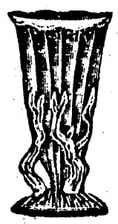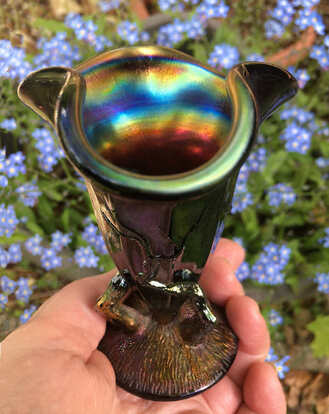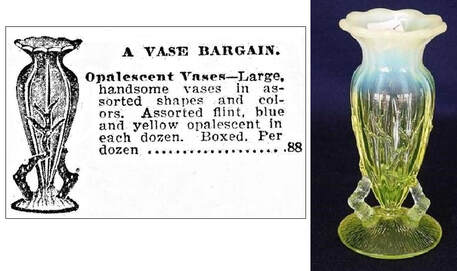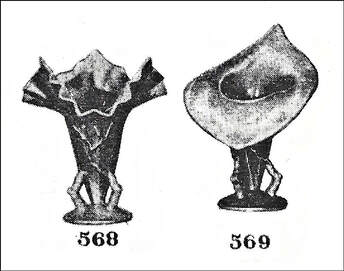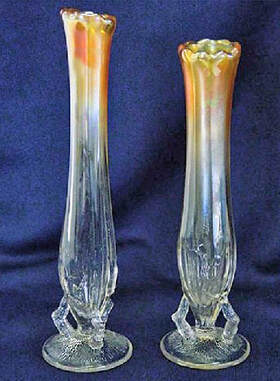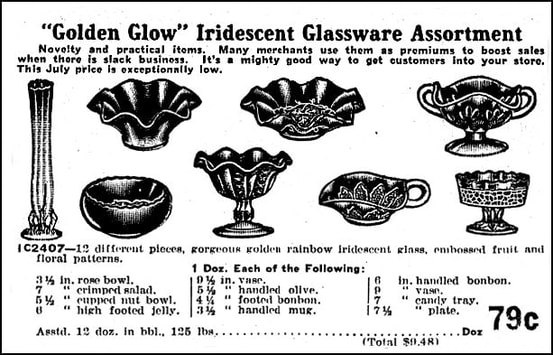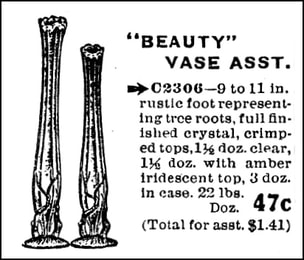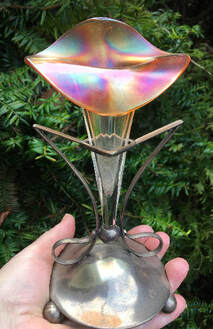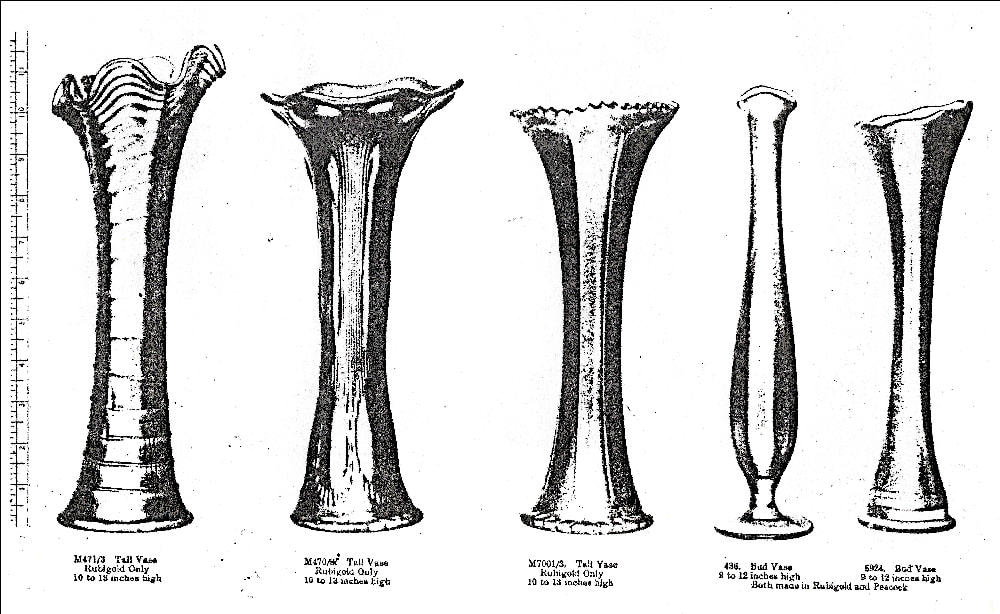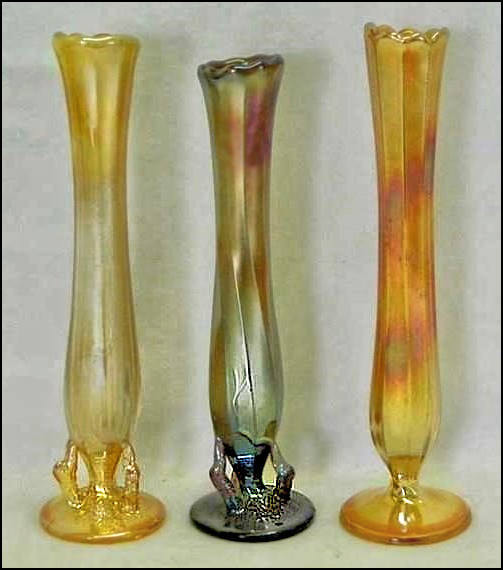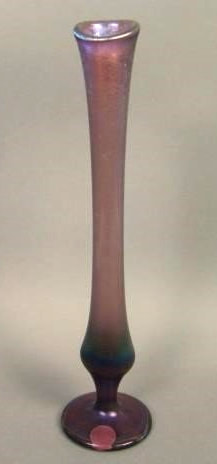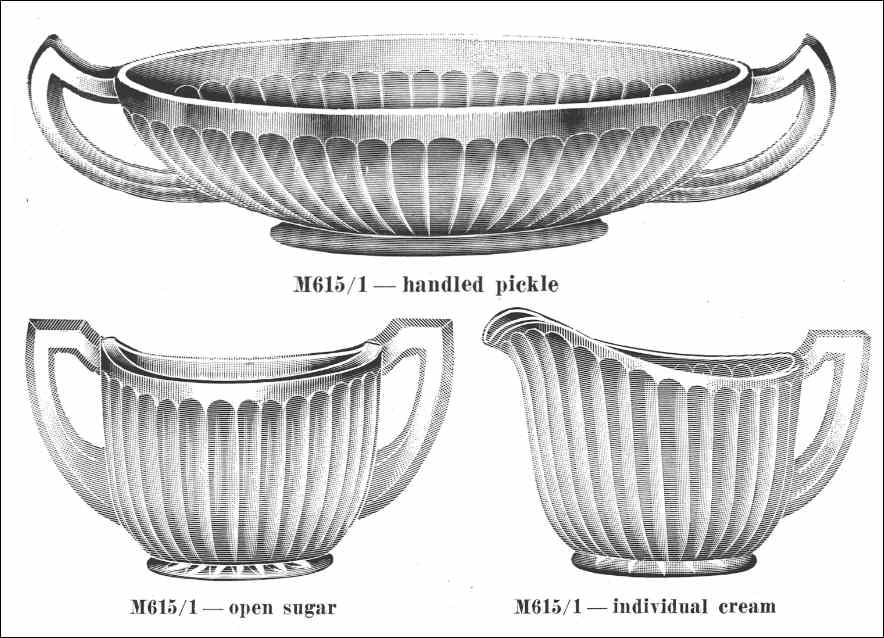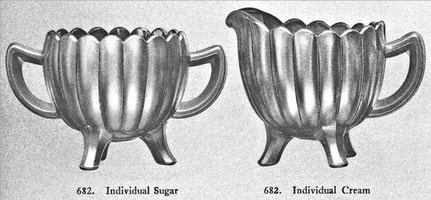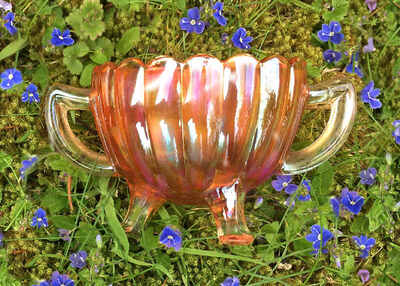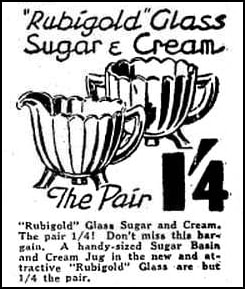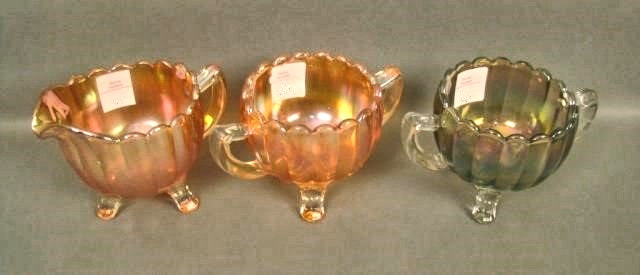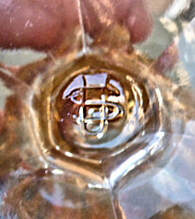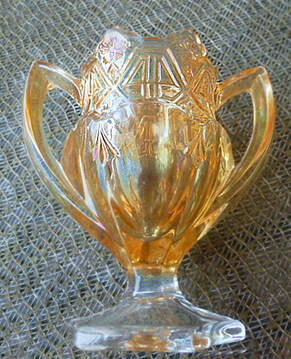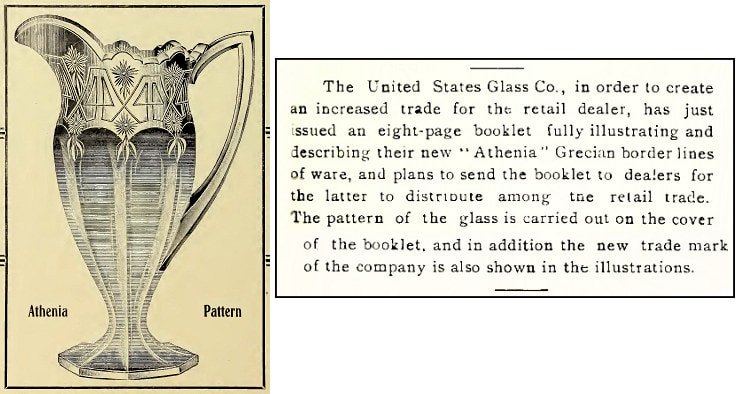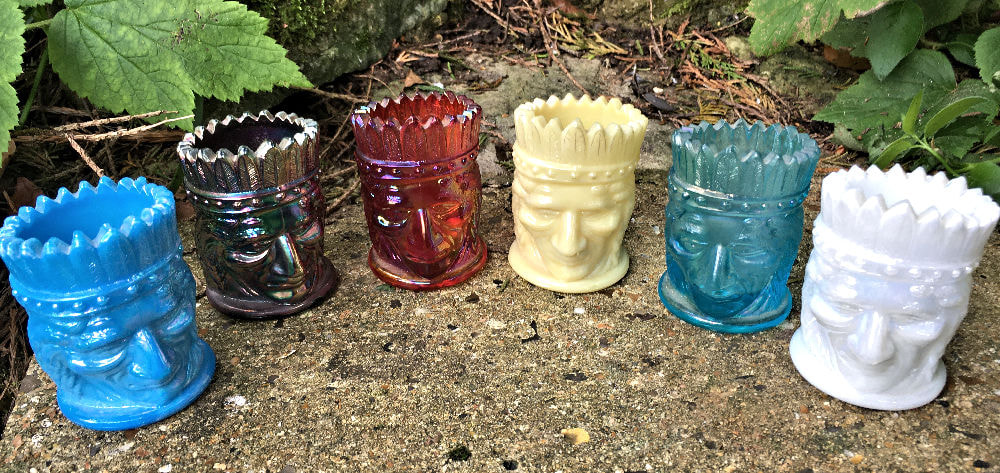NetworK ezine Issue 73. June 2021
Totally Devoted to Carnival Glass
|
Welcome to the June issue of Network in which we look yet again, at some of the fascinating information in old Imperial catalogues. But this time, we have a revelation that will require some corrections and re-writing in many books, articles and other sources.
Hidden in Plain Sight You see, we spotted a vase that has been hidden in plain sight for decades … read on. Back to our Roots Shown on the right is Dugan-Diamond’s Twigs (also known as Tiny Twigs or Little Twigs).
|
Above is a Dugan-Diamond’s Twigs vase in purple Carnival
(also known as Tiny Twigs or Little Twigs) |
On the right (below) are two more fancy shapes of Twigs vases that were shown in Dugan’s own catalogue; again they are opalescent not Carnival. They were in an “Opalescent Novelty Assortment” dated approx. 1906-10. However, to see the bigger picture, we need to roll the clock back even further - all the way to 1898, because this vase was not a Dugan original. It was first made (not in Carnival) by Harry Northwood at the Indiana, PA factory before his cousin Tom Dugan took over that glass works in 1904. The fascinating ad shown below (left) is from an 1898 Sommers catalogue confirms this; the ad featured an opalescent Twigs vase (which was made in two sizes, around 4½ inches and 7 inches) alongside an item from Northwood’s “Alaska” line. It is identical to the later approx. 4 inch Dugan version – note the textured surface of the pedestal base, the twigs and the veiny roots.
On the right (below) are two more fancy shapes of Twigs vases that were shown in Dugan’s own catalogue; again they are opalescent not Carnival. They were in an “Opalescent Novelty Assortment” dated approx. 1906-10. However, to see the bigger picture, we need to roll the clock back even further - all the way to 1898, because this vase was not a Dugan original. It was first made (not in Carnival) by Harry Northwood at the Indiana, PA factory before his cousin Tom Dugan took over that glass works in 1904. The fascinating ad shown below (left) is from an 1898 Sommers catalogue confirms this; the ad featured an opalescent Twigs vase (which was made in two sizes, around 4½ inches and 7 inches) alongside an item from Northwood’s “Alaska” line. It is identical to the later approx. 4 inch Dugan version – note the textured surface of the pedestal base, the twigs and the veiny roots.
|
A 1898 Sommers catalogue illustration showing Northwood’s glass (note this depicts the larger 7 inch vase). Alongside is a 4" vaseline opal example, the smaller of the two Northwood sizes of the original Twig vase (photo courtesy Seeck Auctions).
|
“Opalescent Novelty Assortment” dated approx. 1906-10. Source: Catalog Reprint of Dugan Glass Co. – Jenning’s Design Company.
|
So, to summarise, what we have been looking at so far, have been versions of the small iridised Twigs vases that are familiar to Carnival collectors. They have the same textured top on the top of the pedestal base, the knobbly little twigs (reminiscent of bent knees) and the veiny markings extending up the body of the panelled vase – all are distinctive features of these items.
So far, so good. All the previous information is well researched, understood and accepted. And for the record, collectors tend to refer to the small Dugan vases as (Tiny) Twigs and the later, taller (swung) versions from Diamond, as Beauty Bud.
So far, so good. All the previous information is well researched, understood and accepted. And for the record, collectors tend to refer to the small Dugan vases as (Tiny) Twigs and the later, taller (swung) versions from Diamond, as Beauty Bud.
Mostly everyone will also be familiar with the tall, thin version of this vase that was made somewhat later, in the Diamond years, from around 1916. Also known as the Beauty Bud Vase (or Twigs Bud Vase), the 9 to 11 inch Dugan-Diamond version also has the little twig “bent knees” and the textured base, although the veiny roots are often not easily visible. The tops of these elongated, swung vases are softly scalloped.
Mostly everyone will also be familiar with the tall, thin version of this vase that was made somewhat later, in the Diamond years, from around 1916. Also known as the Beauty Bud Vase (or Twigs Bud Vase), the 9 to 11 inch Dugan-Diamond version also has the little twig “bent knees” and the textured base, although the veiny roots are often not easily visible. The tops of these elongated, swung vases are softly scalloped.
But let’s stop and examine a few things before we get on to the main revelation!
Firstly, it is not at all unusual to find tall Beauty Bud vases that are only partially iridised at the top (as in the two examples above). Surely, this was intentional - but why? Take a look at the Butler Bros. ad below, from 1916. It described an “amber iridescent top” - a clear reference to the partially iridised effect where the lower section of the vase is clear while the top is marigold.
It was an intentional effect and not the result of improper spraying - it was meant to look classy! But again why? In fact, it was intentionally replicating some earlier European Art Glass was selectively iridised in exactly this manner.
|
Extract from Butler Bros. 1916 catalogue showing Dugan-Diamond's “Beauty” vases that are called Beauty Bud by today’s collectors.
|
This fascinating art glass vase on the right is a good example of the marigold iridescent top with clear glass showing below.
It was made in England, possibly by Stevens & Williams of Stourbridge. We can date it by the marking on the Arts and Crafts style metalware holder: it has a hallmark showing it was made by Harrison Fisher of Sheffield, England, between 1897 and 1899. A fore-runner of Carnival Glass, and in a shape and style that was later emulated by various Carnival makers. |
And secondly, the "twigs" are not actually twigs! The design was intended to represent tree roots, as the ad above clearly states. The entire rustic effect – from the textured pedestal base, the bent “knees” and the veiny upward lines – they were meant to be tree roots. The Twig Vases should have been called Root Vases! Marion Hartung had spotted it and she correctly identified the pattern on the Beauty Bud vases as representing tree roots.
Hey Bud
Now let’s get to the revelation. Can you spot the odd one out in the picture on the right? Photo is courtesy of Seeck Auctions.
Now let’s get to the revelation. Can you spot the odd one out in the picture on the right? Photo is courtesy of Seeck Auctions.
|
Could it be the one in the middle, because it is amethyst and the other two are marigold? Look again. The odd one out is actually on the right. It’s different because it does not have the bumpy, rustic bent twigs (roots) at the base. And look again – it does not have the textured bark effect on the pedestal base. This version without the twigs has been deemed a variation of the Beauty Bud vase and is attributed to Dugan-Diamond. Our recent research into some Imperial catalogues has revealed this to be incorrect. Imperial Catalog 200 (c. 1926). The Bud Vase, second from right, is Imperial’s No. 436
and it was offered in Rubigold and Peacock (marigold and clambroth). |
Above: the Beauty Bud vase without the twigs (on the right of this trio) was actually made by Imperial.
It is almost certainly Imperial’s Bud Vase No. 436. The two vases at left and centre are Dugan-Diamond. |
Naturally, we gasped when we saw it in the Imperial Catalog 200 (c. 1926). Then, amazingly, we also found it in an earlier catalogue - the Imperial Second Bargain Book from around 1924. Hidden in plain sight for decades.
|
It is our belief that the familiar “twigless” Carnival Beauty Bud Vases were not made by Dugan-Diamond, as currently believed – they were actually made by Imperial. The catalogues we have studied describe them as being made in Rubigold, Peacock and Rainbow Iridescent (marigold and clambroth); scarce amethyst /purple is also known. The gently scalloped tops were hand-tooled and vary between flat or asymmetrical tops and rounded shapes. These “twigless” Beauty Bud Vases are attributed to Dugan-Diamond in most books, articles and resources, and this has been the received wisdom until now. We propose that the solution for the future should be to refer to these “twigless” versions as Imperial’s Beauty Bud Vase (No. 436). Be aware that the Imperial Beauty Bud Vase (436) has also been mis-identified as a Fenton bud vase, usually referred to as Fenton No. 251 as both have an asymmetrical top and neither have twigs.* Fenton's 251 is seen in catalogues from around 1921 but were mainly produced in stretch glass colours, such as celeste blue. It has a distinct difference in the profile. Fenton's version has a slightly longer stem and a distinctly wider and pronounced angular bulge at the bottom of the body – and of course, it is predominantly found in stretch glass. We believe the Imperial Beauty Bud Vase (436) has been mis-identified as a Fenton vase owing to the fact that both sometimes have an asymmetrical top (and of course, neither have twigs!). * The No. 251 bud vase is around 10 to 12 inches high. Another Fenton bud vase - No. 354 - is identical but shorter at 8 inches high. |
Imperial’s Bud Vase No. 436.
From Imperial’s Second Bargain Book (c.1924), offered in Rainbow Iridescent Glass (a light clambroth). |
Fenton’s No. 251 in Wisteria stretch. Courtesy Burns Auctions.
|
How to tell the difference
Let’s bring some clarity to the mix.
Beauty Bud Vases with twigs (roots) at the bottom and a textured bark effect on the pedestal are Dugan-Diamond (marigold top /clear bottom, marigold and scarce amethyst). Usually have gently scalloped tops which may occasionally be asymmetrical.
Beauty Bud Vases with no twigs at the bottom and no textured bark effect on the pedestal are Imperial Beauty Bud No. 436 (marigold, clambroth and scarce amethyst). Usually have gently scalloped tops which may occasionally be asymmetrical.
Bud Vases in stretch glass (the stretch colours include celeste, wisteria, velva rose, Florentine green and topaz) are Fenton’s 354 (8 inch) or 251 (10 to 12 inch). Tops may be asymmetrical or other shapes including JIPs.
Conclusion
Often scathingly dismissed, probably because of their availability or low value, these Beauty Bud Vases are seen as the “poor cousin” of the Tiny Twigs vases. And yet they encapsulate the spirit and heart of Carnival Glass. From their Northwood non-Carnival origins in the late 1890s, when they were inspired by the popular rustic theme of the era – through the Dugan production of the early 1900s and the subsequent Diamond output when the bud vases made their debut – and on to the spin-off versions made by Imperial and Fenton – this progression satisfied the public’s desire for beautiful glass at an affordable price.
These bud vases would have brought an elegant touch to the humblest of dwellings. Possibly holding a modest floral offering or for a special occasion, maybe a single rose. Low priced and affordable at around 4 cents each (wholesale) in 1916 – about half the cost of most other cheap vases – their iridescence surely added a touch of glamour to the lives of many.
And now we can give Imperial’s Bud Vase its rightful place in history. No longer should it be hidden in plain sight and passed off as a (twigless) Dugan-Diamond vase. We have made the corrections on our own website. Hopefully corrections will follow soon elsewhere.
Let’s bring some clarity to the mix.
Beauty Bud Vases with twigs (roots) at the bottom and a textured bark effect on the pedestal are Dugan-Diamond (marigold top /clear bottom, marigold and scarce amethyst). Usually have gently scalloped tops which may occasionally be asymmetrical.
Beauty Bud Vases with no twigs at the bottom and no textured bark effect on the pedestal are Imperial Beauty Bud No. 436 (marigold, clambroth and scarce amethyst). Usually have gently scalloped tops which may occasionally be asymmetrical.
Bud Vases in stretch glass (the stretch colours include celeste, wisteria, velva rose, Florentine green and topaz) are Fenton’s 354 (8 inch) or 251 (10 to 12 inch). Tops may be asymmetrical or other shapes including JIPs.
Conclusion
Often scathingly dismissed, probably because of their availability or low value, these Beauty Bud Vases are seen as the “poor cousin” of the Tiny Twigs vases. And yet they encapsulate the spirit and heart of Carnival Glass. From their Northwood non-Carnival origins in the late 1890s, when they were inspired by the popular rustic theme of the era – through the Dugan production of the early 1900s and the subsequent Diamond output when the bud vases made their debut – and on to the spin-off versions made by Imperial and Fenton – this progression satisfied the public’s desire for beautiful glass at an affordable price.
These bud vases would have brought an elegant touch to the humblest of dwellings. Possibly holding a modest floral offering or for a special occasion, maybe a single rose. Low priced and affordable at around 4 cents each (wholesale) in 1916 – about half the cost of most other cheap vases – their iridescence surely added a touch of glamour to the lives of many.
And now we can give Imperial’s Bud Vase its rightful place in history. No longer should it be hidden in plain sight and passed off as a (twigless) Dugan-Diamond vase. We have made the corrections on our own website. Hopefully corrections will follow soon elsewhere.
Handling the Problem
|
Are you familiar with Imperial’s No. 615? It’s one of those patterns that the moment you look at it, you “know” it, and yet you are not entirely sure of its pattern name. It’s actually called Lustre and Clear (the name was given by Marion Hartung) but Imperial just gave it the pattern number.
In the illustration, right, you can see a handled pickle, open sugar and individual cream – each has the number 615 and the prefix M, which denotes the offering was in Rubigold (marigold). The plain rib pattern is interior while the outside is smooth. But just look at the handles. The sugar and cream jug have Chippendale style, square top handles, while the pickle is curved and pointed upwards. That’s most unusual – generally speaking, features such as a distinctive style of handle would be consistent throughout a pattern line. But here we see two different style handles on the same pattern. This inconsistency has probably added to its frequent misidentification. The name “Lustre and Clear” is perplexing, suggesting that the items are partially iridised. In fact, it seems that Marion Hartung named it thus, as she had seen examples in marigold (lustre) and also in crystal (clear). Lustre and Clear is often confused (and conflated) with a somewhat similar pattern from Imperial called Pillar Flute, which is Imperial’s No. 682, introduced in the 1920s. The plain, thin-panel pattern is exterior, and the tops of all pieces have a distinctive scalloped top, synchronized with the thin panels or ribs. A range of table ware shapes is known, with a number of them bearing the Imperial Iron Cross mark. |
Lustre and Clear, Imperial’s No. 615. Extract from Imperial Second Bargain Book, c. 1924. Courtesy Jon D Bartell.
|
|
Imperial’s No. 682 sugar and creamer, known as Pillar Flute. From Imperial Second Bargain Book, c. 1924. Courtesy Jon D Bartell.
Note the handle shape – it has an upward curve that is very similar to (but not exactly identical with) the curved handle on the Lustre and Clear pickle. They are tiny pieces: the sugar just reaches 3 inches, and the creamer is slightly larger, standing 3½ inches high). |
Imperial’s Pillar Flute sugar in marigold.
|
Frequent mis-identification coupled with subsequent copying of the mistakes, has caused the two patterns to become muddled and conflated. So here is a brief aide-memoire in addition to the clear information above.
Lustre and Clear – the moulded panelled pattern is inside, while the exterior is smooth and un-patterned. The tops of pieces are smooth.
Pillar Flute – the moulded rib (pillar) pattern is all exterior, while the inside is smooth and plain. The tops of pieces are scalloped.
Athenia: “The pattern that’s distinctive” (Crockery & Glass Journal, 1912)
|
In Network #70 we showed a United States Glass Company (US Glass) 1911 ad for their new Athenia pattern. It’s a fascinating design, described by US Glass as being “Grecian in design combined with a floral decoration on the daisy border.
The shape is somewhat Colonial.” The pattern is also known by collectors as Reverse 44 or Paneled 44, owing to the distinctive motif in the design. When we showed the ad a couple of months ago, we had not realised that rare examples of this pattern are known in Carnival. And here is a wonderful example, courtesy of Greg Dilian, that was featured in our Carnival NetworK Facebook Group recently.
|
|
Right: the Athenia design as shown in a US Glass ad in the Crockery & Glass Journal, 1911 (immediate right), and subsequently further referenced in 1912 (far right). It's particularly interesting that US Glass had issued an 8-page booklet about their Athenia line, which they had distributed to the retail trade. |
|
The "Hobby Lobby"
"Along with worldly woes and money matters, there's talk on Capitol Hill about a White Carnival Glass Indian Chief toothpick holder" We were intrigued when we spotted this in a Washington newspaper from 1973. Carnival Glass being discussed at the centre of US Government! Naturally, we had to research this! It led us on a fascinating journey into what might have been ... if only. The story is being worked on as this Issue goes to pixel, and all will be revealed in the next Issue of NetworK. Right: Indian Chief (aka Indian Head) toothpicks in a range of Contemporary Carnival colours. These were made by St. Clair. |
If you have missed any of the previous issues of NetworK and NetworK Specials, they are all here: Back Issues.
Privacy and the use of your information: we only use your name and email address to send you your FREE Carnival Glass NetworK ezine. We will not share your name or email address with anyone else, or use it for any other purpose. You can change your mind about receiving your NetworK ezine at any time by clicking the unsubscribe link at the foot of every issue, or by emailing us at [email protected]
Join us on Facebook
We would love you to come and join in the fun, and we invite you and your friends to join us all on NetworK's fast growing and very active Facebook Group!
We would love you to come and join in the fun, and we invite you and your friends to join us all on NetworK's fast growing and very active Facebook Group!

